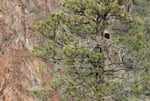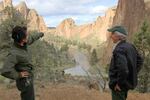Smith Rock State Park naturalist Dave Vick peered through his spotting scope perched on a red rock cliff. He pointed the scope toward a tall ponderosa pine, spotting a downy mass in the middle of a 6-foot-wide nest. Inside was a 2-week-old bald eagle, or eaglet, named Solo because he was the only hatchling in this year's brood.
The floppy little bird was guarded by a stately adult bald eagle — one of the two in a nesting pair that lives here year-round. Solo then stared expectantly at the parent bird, opening his beak slightly.
It was a typical quiet, spring day for these raptors and the many other species in the park. But come August, Solo and the other park wildlife will experience a rare celestial event — a total solar eclipse that will travel across the entire midsection of Oregon. For two minutes, the park will go dark. Nocturnal creatures will stir, daytime animals will fall asleep, and the temperature will drop dramatically and suddenly.

Bald eagles nest in Smith Rock State Park every year. Wildlife officials worry about the impacts a major influx of visitors may have on bald eagles and other species.
Amanda Peacher / OPB
Thousands of human visitors are expected to visit the state park, and many other wild places within the eclipse's path, to experience the rare event. And land managers are expecting still more people who want to experience the eclipse in a memorable, wild setting to flock to rivers, wilderness areas, mountain peaks and lakes.
All those people amount to a huge amount of planning for public lands agencies — and potential problems.
All reservable campsites at Smith Rock are booked for the eclipse. The same goes for pretty much every other state park, U.S. Forest Service, and Bureau of Land Management campsite, as well as cabins, vacation rentals and motels within the path of totality. With all bookable lodging taken, eclipse watchers are expected to spill over onto public lands to see the event.
Related: OPB's Coverage Of The Oregon Solar Eclipse 2017
Estimates of as many as 1 million visitors means land managers are working hard to protect the many sensitive, wild places within the 70-mile belt of the eclipse.
That includes educating visitors on how to protect wildlife. In addition to bald eagles and other raptors at Smith Rock, there are river otters, nesting golden eagles, mule deer, snakes and more. Huge crowds of human visitors can interrupt critters that are hunting, sleeping or caring for their young.
“The biggest issue is just stress for the wildlife,” Vick said.
Stress can lead to sickness, weakness or even death for sensitive species. He’s particularly worried about bald eagles being harassed by drone users. Drones are banned in Smith Rock park, in part because of their noise. But during a special event such as the eclipse, there might be some rule-breakers who want photos of the celestial event.
“All these sheer cliffs really amplify and echo that noise,” he said.

Smith Park naturalist Dave Vick is concerned that expected crowds during the solar eclipse could impact wildlife like the park's resident bald eagles.
Amanda Peacher / OPB
Also within the park are delicate, ground-dwelling mosses and lichens that can be easily crushed.
Land managers are concerned about potential damage to places like the John Day Fossil Beds, where one misstep can destroy irreplaceable fossils, and pristine spots within the Mount Jefferson Wilderness Area that could be overrun with illegal fires, trash and human waste.
Land agencies teamed up to create a special blog where campers and and other visitors can get information about the eclipse and public lands.
Budget-strapped agencies like the Forest Service already face challenges with hiring an adequate number of wilderness rangers and law enforcement officers. Smith Rock State Park has only five full-time staffers plus a few volunteers. Rangers from other parks will be on site for the eclipse, but that’s still just a handful of employees for thousands of visitors.
That equation will be about the same at Forest Service and BLM campgrounds, trails and dirt roads. And with the eclipse happening during one of the hottest months of the year, there’s one topic that comes up at every eclipse planning meeting: wildfire.
“We’re concerned about fire danger,” said Josie Barnum, another Smith Rock ranger.
She’s hoping visitors obey the parks’s bans on campfires and smoking.
“The idea of evacuating all those people on a normal day in a fire is very frightening,” Barnum said. “To think about it happening when there’s double or triple volume of people in the park would be really, really terrifying.”
With so many people in these wild spaces, the likelihood of serious injuries requiring search and rescue teams goes up. Rescues gobble up time and resources.
“That takes staff away from other priorities happening up here,” Barnum said. And that’s assuming rescue crews can even get to an injured hiker. Highways and roads are expected to be clogged on the day of the eclipse.
To limit crowding, officials will close the road into the park once it’s full. Latecomers will have to walk 1/2 mile or more to reach the entrance. Sheriff's deputies and fire crews will be staged nearby. The park will have emergency medics at the ready on the canyon rim. There will be education and interpretive sites about "Leave No Trace" ethics and parks rules banning drones, smoking and fire.

Ranger Josie Barnum and park director Scott Brown survey the valley in Smith Rock State Park. The park already sees crowds of at least 2,000 visitors on a weekend day. During the solar eclipse, there could be double or triple the visitor volume.
Amanda Peacher / OPB
Agencies all across Oregon are taking similar precautions to protect places in the eclipse path, including the Painted Hills and the Mount Jefferson Wilderness.
But despite all the extra work and necessary precautions that go into planning for a day like this, Barnum is excited to experience the eclipse in the place where she works.
“Smith Rock is definitely a very special place,” Barnum said. “If we can preserve it and give people an amazing experience watching the eclipse when they come out here, that’s pretty cool. It makes me feel good about what we do."